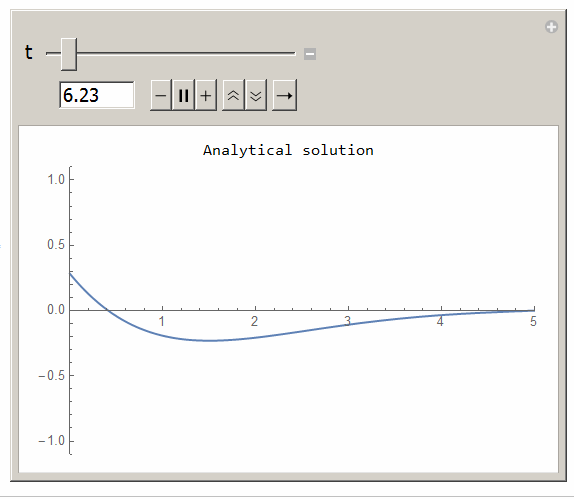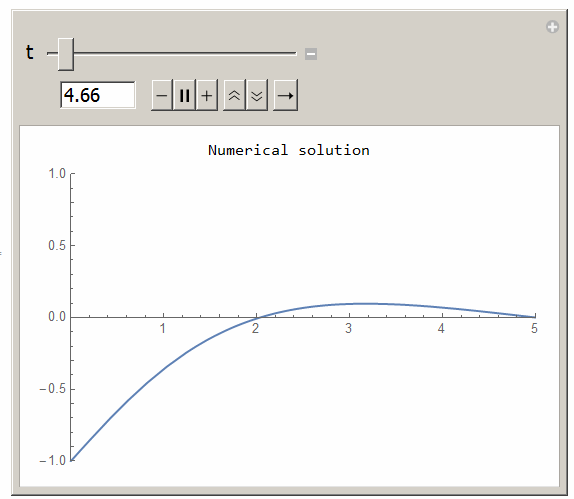 |
Solve
\begin {align} \frac {\partial u}{\partial t} & =k\frac {\partial ^{2}u}{\partial x^{2}}\tag {1}\\ 0 & <x<L\nonumber \\ t & >0\nonumber \end {align}
Initial conditions
\[ u\left ( 0,x\right ) =0 \]
Boundary conditions
\begin {align*} u\left ( 0,t\right ) & =\sin \left ( t\right ) \\ u\left ( t,L\right ) & =0 \end {align*}
Let \begin {equation} u=v+u_{E} \tag {2} \end {equation} where \(u_{E}\left ( x,t\right ) \) is steady state solution that only needs to satisfy boundary conditions and \(v\left ( x,t\right ) \) satisfies the PDE itself but with homogenous B.C. At steady state, the PDE becomes
\begin {align*} 0 & =k\frac {d^{2}u_{E}}{dx^{2}}\\ u_{E}\left ( 0\right ) & =\sin \left ( t\right ) \\ u_{E}\left ( L\right ) & =0 \end {align*}
The solution is \(u_{E}\left ( t\right ) =\left ( \frac {L-x}{L}\right ) \sin \left ( t\right ) \). Hence (2) becomes
\[ u\left ( x,t\right ) =v\left ( x,t\right ) +\left ( \frac {L-x}{L}\right ) \sin \left ( t\right ) \]
Substituting the above in (1) gives
\begin {align} \frac {\partial v}{\partial t}+\left ( \frac {L-x}{L}\right ) \cos \left ( t\right ) & =k\frac {\partial ^{2}v}{\partial x^{2}}\nonumber \\ \frac {\partial v}{\partial t} & =k\frac {\partial ^{2}v}{\partial x^{2}}+\left ( \frac {x-L}{L}\right ) \cos \left ( t\right ) \nonumber \\ \frac {\partial v}{\partial t} & =k\frac {\partial ^{2}v}{\partial x^{2}}+Q\left ( x,t\right ) \tag {3} \end {align}
With boundary conditions \(u_{0}\left ( 0,t\right ) =0,u\left ( L,t\right ) =0\). This is now in standard form and separation of variables can be used to solve it. \[ Q\left ( x,t\right ) =\left ( \frac {x-L}{L}\right ) \cos \left ( t\right ) \] Now acts as a source term. The eigenfunctions are known to be \(\Phi _{n}\left ( x\right ) =\sin \left ( \sqrt {\lambda _{n}}x\right ) \) where \(\lambda _{n}=\left ( \frac {n\pi }{L}\right ) ^{2}\). Hence by eigenfunction expansion, the solution to (3) is
\begin {equation} v\left ( x,t\right ) =\sum _{n=1}^{\infty }B_{n}\left ( t\right ) \Phi _{n}\left ( x\right ) \tag {3A} \end {equation}
Substituting this into (3) gives
\begin {equation} \sum _{n=1}^{\infty }\frac {dB_{n}\left ( t\right ) }{dt}\Phi _{n}\left ( x\right ) =k\sum _{n=1}^{\infty }B_{n}\left ( t\right ) \Phi _{n}^{\prime \prime }\left ( x\right ) +Q\left ( x,t\right ) \tag {4} \end {equation}
Expanding \(Q\left ( x,t\right ) \) using same basis (eigenfunctions) gives
\[ Q\left ( x,t\right ) =\sum _{n=1}^{\infty }q_{n}\left ( t\right ) \Phi _{n}\left ( x\right ) \]
Applying orthogonality
\begin {align*} \int _{0}^{L}Q\left ( x,t\right ) \Phi _{m}\left ( x\right ) dx & =\int _{0}^{L}\sum _{n=1}^{\infty }q_{n}\left ( t\right ) \Phi _{n}\left ( x\right ) \Phi _{m}\left ( x\right ) dx\\ & =\sum _{n=1}^{\infty }q_{n}\left ( t\right ) \int _{0}^{L}\Phi _{n}\left ( x\right ) \Phi _{m}\left ( x\right ) dx \end {align*}
But \(\sum _{n=1}^{\infty }\int _{0}^{L}\Phi _{n}\left ( x\right ) \Phi _{m}\left ( x\right ) dx=\int _{0}^{L}\Phi _{m}^{2}\left ( x\right ) dx=\frac {L}{2}\) since \(\Phi _{n}\left ( x\right ) =\sin \left ( \frac {n\pi }{L}x\right ) \) and the above simplifies to
\begin {align*} \int _{0}^{L}Q\left ( x,t\right ) \Phi _{n}\left ( x\right ) dx & =\frac {L}{2}q_{n}\left ( t\right ) \\ q_{n}\left ( t\right ) & =\frac {2}{L}\int _{0}^{L}Q\left ( x,t\right ) \sin \left ( \frac {n\pi }{L}x\right ) dx \end {align*}
But \(Q\left ( x,t\right ) =\left ( \frac {x-L}{L}\right ) \cos \left ( t\right ) \), hence
\begin {align*} q_{n}\left ( t\right ) & =\frac {2}{L}\int _{0}^{L}\left ( \frac {x-L}{L}\right ) \cos \left ( t\right ) \sin \left ( \frac {n\pi }{L}x\right ) dx\\ & =\frac {-2}{n\pi }\cos \left ( t\right ) \end {align*}
Therefore \(Q\left ( x,t\right ) =\sum _{n=1}^{\infty }q_{n}\left ( t\right ) \Phi _{n}\left ( x\right ) =\sum _{n=1}^{\infty }\frac {-2}{n\pi }\cos \left ( t\right ) \sin \left ( \frac {n\pi }{L}x\right ) \) and (4) becomes
\begin {align*} \sum _{n=1}^{\infty }\frac {dB_{n}\left ( t\right ) }{dt}\Phi _{n}\left ( x\right ) & =k\sum _{n=1}^{\infty }B_{n}\left ( t\right ) \Phi _{n}^{\prime \prime }\left ( x\right ) -\sum _{n=1}^{\infty }\frac {2}{n\pi }\cos \left ( t\right ) \sin \left ( \frac {n\pi }{L}x\right ) \\ \frac {dB_{n}\left ( t\right ) }{dt}\sin \left ( \frac {n\pi }{L}x\right ) & =kB_{n}\left ( t\right ) \left ( -\frac {n^{2}\pi ^{2}}{L^{2}}\sin \left ( \frac {n\pi }{L}x\right ) \right ) -\frac {2}{n\pi }\cos \left ( t\right ) \sin \left ( \frac {n\pi }{L}x\right ) \\ \frac {dB_{n}\left ( t\right ) }{dt}+B_{n}\left ( t\right ) k\frac {n^{2}\pi ^{2}}{L^{2}} & =-\frac {2}{n\pi }\cos \left ( t\right ) \end {align*}
This is an ODE in \(B_{n}\left ( t\right ) \) whose solution is
\[ B_{n}\left ( t\right ) =C_{n}e^{-k\left ( \frac {n^{2}\pi ^{2}}{L^{2}}\right ) t}-\frac {2L^{2}\left ( kn^{2}\pi ^{2}\cos t+L^{2}\sin t\right ) }{n\pi \left ( L^{4}+k^{2}n^{4}\pi ^{4}\right ) }\]
From (3A) \(v\left ( x,t\right ) \) now becomes
\begin {equation} v\left ( x,t\right ) =\sum _{n=1}^{\infty }C_{n}e^{-k\left ( \frac {n^{2}\pi ^{2}}{L^{2}}\right ) t}\sin \left ( \frac {n\pi }{L}x\right ) -\frac {2L^{2}\left ( kn^{2}\pi ^{2}\cos t+L^{2}\sin t\right ) }{n\pi \left ( L^{4}+k^{2}n^{4}\pi ^{4}\right ) }\sin \left ( \frac {n\pi }{L}x\right ) \tag {5} \end {equation}
To find \(C_{n}\), from initial conditions, at \(t=0\) the above becomes
\[ 0=\sum _{n=1}^{\infty }C_{n}\sin \left ( \frac {n\pi }{L}x\right ) -\frac {2L^{2}\left ( kn^{2}\pi ^{2}\right ) }{n\pi \left ( L^{4}+k^{2}n^{4}\pi ^{4}\right ) }\sin \left ( \frac {n\pi }{L}x\right ) \]
Hence
\[ C_{n}=\frac {2L^{2}\left ( kn^{2}\pi ^{2}\right ) }{n\pi \left ( L^{4}+k^{2}n^{4}\pi ^{4}\right ) }\]
Therefore (5) becomes
\[ v\left ( x,t\right ) =\sum _{n=1}^{\infty }\left ( \frac {2L^{2}\left ( kn^{2}\pi ^{2}\right ) }{n\pi \left ( L^{4}+k^{2}n^{4}\pi ^{4}\right ) }e^{-k\left ( \frac {n^{2}\pi ^{2}}{L^{2}}\right ) t}-\frac {2L^{2}\left ( kn^{2}\pi ^{2}\cos t+L^{2}\sin t\right ) }{n\pi \left ( L^{4}+k^{2}n^{4}\pi ^{4}\right ) }\right ) \sin \left ( \frac {n\pi }{L}x\right ) \]
And since \(u=v+u_{E}\) then the solution is
\[ u\left ( x,t\right ) =\left ( \sum _{n=1}^{\infty }\left ( \frac {2L^{2}\left ( kn^{2}\pi ^{2}\right ) }{n\pi \left ( L^{4}+k^{2}n^{4}\pi ^{4}\right ) }e^{-k\left ( \frac {n^{2}\pi ^{2}}{L^{2}}\right ) t}-\frac {2L^{2}\left ( kn^{2}\pi ^{2}\cos t+L^{2}\sin t\right ) }{n\pi \left ( L^{4}+k^{2}n^{4}\pi ^{4}\right ) }\right ) \sin \left ( \frac {n\pi }{L}x\right ) \right ) +\left ( \frac {L-x}{L}\right ) \sin \left ( t\right ) \]
To simulate
ClearAll[t, x, n] k = 1; L0 = 5; max = 400; u[x_, t_] = Sum[(((2*L0^2*(k*n^2*Pi^2))/(n*Pi*(L0^4 + k^2*n^4*Pi^4)))* Exp[(-k)*((n^2*Pi^2)/L0^2)*t] - (2*L0^2*(k*n^2*Pi^2*Cos[t] + L0^2*Sin[t]))/(n* Pi*(L0^4 + k^2*Pi^4*n^4)))*Sin[((n*Pi)/L0)*x], {n, 1, max}] + ((L0 - x)/L0)*Sin[t]; Manipulate[Grid[{{"Analytical solution"}, {Plot[Evaluate[u[x,t]],{x,0,5},PlotRange->{{0,5},{-1.1,1.1}}, ImageSize->400]}}], {{t,0,"t"},0,100,.01} ]
Here is the animation from the above
 |
Here is the numerical solution to compare with
ClearAll["Global`*"]; pdeset = {Derivative[1, 0][U][t, x] == Derivative[0, 2][U][t, x]} ics = {U[0, x] == 0}; bcs = {U[t, 0] == Sin[t], U[t, 5] == 0}; ibcAll = {ics, bcs}; numericalSol = NDSolve[{pdeset, ibcAll}, U, {t, 0, 100}, {x, 0, 5}]; Manipulate[Grid[{{"Numerical solution"}, {Plot[Evaluate[U[t, x] /. numericalSol], {x, 0, 5}, PlotRange -> {{0, 5}, {-1, 1}}, ImageSize -> 400]}}], {{t, 0, "t"}, 0, 100, .01} ]
Here is the animation from the above
 |
Reference: stokes second problem question and answer